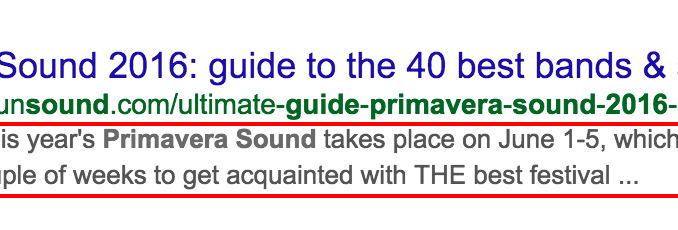
What is a meta description and do you write one?
In this post we’ll look at what they are, why they’re important, and examples, both good and bad.
What are meta tags?
Meta tags are HTML elements that provide information about a webpage for search engines and website visitors.
There are two elements that must be placed as tags in the <head> section of a HTML document. These elements are:
Title tag
Meta description
We recently discussed title tags in a post on Search Engine Watch, so now let’s move straight into meta descriptions.
What is a meta description?
It’s the short paragraph of text placed in the HTML of a webpage that describes its content.
Crucially, it’s what will appear under your page’s URL in the search results. This is also known as a snippet. It’s an opportunity to describe / sell the site or page to potential visitors.
The meta description also appear when people share your articles across different websites and social channels.
Where do I add the meta description on my site?
You can add a meta description in the <head> section of your site’s HTML.
It should look something like this:
<head>
<meta name=”description” content=”Here is a precise description of my awesome webpage.”>
</head>
You should have complete control of your meta description in your CMS, particularly if you’re using WordPress.
If you use an SEO plug-in, such as Yoast, you can add a meta description to the ‘meta description’ section, and you can preview an example of how it will look in search engine results pages (SERPs):
Why are meta descriptions important?
It helps the searcher to decide whether or not to visit your page as they see it in search results.
The more descriptive and alluring the description, the more likely it is to attract clicks.
Are meta descriptions used as a ranking signal?
Well, Google has stated that meta descriptions are NOT used as a ranking signal.
However, the quality and relevance of the description will have an influence click-through rate, which will in turn influence rankings, so it is very important.
A meta description checklist
Keywords: make sure your most important keywords from the page show up in the meta description. Often search engines will highlight such keywords in bold where it finds the searchers query in your snippet.
Readable copy: this is essential. Keyword stuffing your meta description is not a good idea. It won’t help with the search engines and it signals to the searcher that your’s is a spammy website. The description should read like a normal sentence written by a human being.
Treat the meta description like an advert for your web-page: it needs to be as compelling and as relevant as possible. It’s vital that the description matches the content on the page.
Length: a meta description should be no longer than 135 – 160 characters long (although Google has recently been testing longer snippets so this could change in future). Any longer and search engines will chop the end off, so make sure any important keywords are nearer the front.
Do not duplicate meta descriptions: As with title tags, the meta descriptions must be written differently for every page. Google could penalise you for duplicating your meta descriptions en masse.
Consider using rich snippets: by using schema markup you can add elements to the snippets to increase their appeal. For instance: star ratings, customer ratings, product information, calorie counts etc.
Examples of meta descriptions: the good
Here are a few examples of appealing meta descriptions that tick the above criteria.
‘best burgers in london’
Although the keywords are further down the description than perhaps they could be, the reason why this result is so appealing is the way the copy draws you in with emotive (and mouth-watering) language.
‘captain america civil war review’
This has markup to show the star rating, while the meta description is short, snappy and contains a call to action.
‘meta descriptions’
Things really are getting too meta. Here Moz has managed to exactly describe what a meta description is, within its own meta description, which is terribly helpful.
Do note that the snippet is a lot longer than normally allowed by Google.
Examples of meta descriptions: the bad
‘best burgers in london’
I’m not really interested in the history of rubbish burgers in London, I want to know where to get a tasty burger now! The phrase ‘soggy buns and grey meat patties’ doesn’t really help to sell this page.
This meta description also fails to include the ‘best’ keyword from its own title tag.
‘captain america civil war review’
There is some rich snippet markup, but the text is muddled and merely copies the title tag directly rather than offering a different enticement.
It’s also far too long, and cuts off mid-sentence.
‘meta descriptions’
I’m not sure if there’s something blocking Google’s ability to crawl the webpage properly, but a website called ‘High Rankings’ should really know better than this…
Source: ClickZ
Link: Writing meta descriptions for SEO: a best practice checklist



Leave a Reply